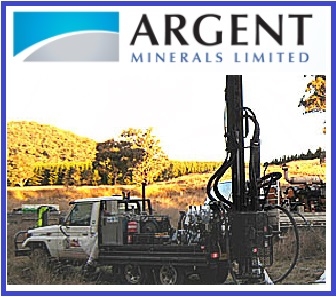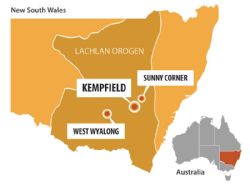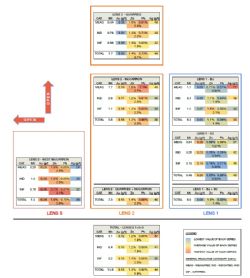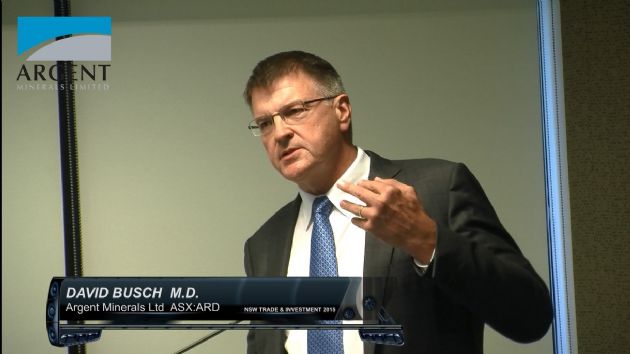 Base and Precious Metal Grade Zonation in Kempfield Resource
Base and Precious Metal Grade Zonation in Kempfield Resource
Sydney, Oct 16, 2014 AEST (ABN Newswire) - Argent Minerals Limited ( ASX:ARD) (Argent, Argent Minerals or the Company) is pleased to provide base and precious metal grade zonation information for the Kempfield Polymetallic Project Mineral Resource.
ASX:ARD) (Argent, Argent Minerals or the Company) is pleased to provide base and precious metal grade zonation information for the Kempfield Polymetallic Project Mineral Resource.
Highlights include:
- Clear metal zonation trends for zinc, lead, gold and silver grades point to a higher depositional temperature to the west of the deposit - associated with a VMS feeder zone
- The metal zonation trends are consistent with the Eastern Australian Palaeozoic deposit group that includes e.g. Thalanga (Red River Resources) and Balcooma - QLD, Woodlawn (Heron Resources) - NSW, and in Tasmania - Rosebery (MMG), and Que River. The scientifically correct peer group for Kempfield (established by Professor Ross Large) includes some of the richest deposits in Australia and has been a major source of base metals supply over a period of one hundred years
The information in this announcement will be referred to in future ASX announcements, including in relation to the analysis of the magnetometric resistivity (MMR) survey, and the formulation of the Kempfield drill testing plan, both of which are nearing completion.
The detailed Mineral Resource estimate performed by resource specialists H&S Consultants Pty Ltd (H&SC) provides silver, lead, zinc and gold grades for each volcanogenic massive sulphide (VMS) mineralisation zone and lens group for the primary material of the Kempfield deposit.
The estimate reveals clear metal zonation patterns that provide further tangible evidence pointing to the potential for a high temperature feeder zone in the largely untested area immediately to the west of the existing deposit, and the associated potential for rich base and precious metal grades.
Combined lead and zinc base metal grades increase progressively from 0.92% in the East (Lens 1 - BJ Zone, Measured category) to 3.1% in the West (Lens 3 - West McCarron Zone Inferred category). Gold grades increase from 0.03 g/t in the East to 0.46 g/t in the West for the same zones. A similar pattern is observed within the West McCarron Zone, where gold grades increase with depth.
Immediately further to the west of the Mineral Resource, on the western edge of the Lens 3 West McCarron zone, is the high grade mineralisation intersected by hole AKDD159: 18 m @ 9.8% Pb/Zn, 113 g/t Ag & 0.26 g/t Au from 85 m including 5 m @ 17.9% Pb/Zn, 259 g/t Ag & 0.34 g/t Au from 88 m (see 10 March 2014 announcement).
These intercepts are not yet included in the Mineral Resource estimate.
The metal grade zonation trends in the Kempfield deposit, now quantified by this new level of detail, provide further clear and tangible evidence of base and precious metal depositional processes consistent with the Eastern Australian Palaeozoic VMS deposit model established by Professor Ross Large (p. 11, 27 Aug 2014 presentation).
The new evidence, in the context of Professor Large's research, points to the potential for rich base and precious metal grades in the large, untested area immediately to the west of, and adjacent to, the Kempfield deposit. This area, for which Argent is finalising geophysics analysis and a diamond drill testing plan, hosts the historic Colossal Reef copper mine and strong Cu anomalies in soil geochemistry. Professor Large has also noted similarities in the alteration of the host rocks at the Kempfield deposit to the footwall of the Que River deposit in Tasmania, one of the richest Eastern Australian Palaeozoic VMS deposits.
Figure 1 in link below sets out the new Mineral Resource estimate information by VMS lens and mineralisation zone for the primary (fresh rock) material, based on a 50 g/t silver equivalent cutoff grade (see Note 1 in the accompanying Mineral Resource Statement).
Figure 1 Explanation
The metal grade information in Figure 1 is set out in a single table for each mineralisation zone, with the tables arranged in groups that approximate the layout of VMS Lens 1, Lens 2 and Lens 3 based on a plan view of the deposit. Additional tables are provided to summarise the information for each VMS lens, and for the entire Primary material portion of the Mineral Resource.
Within each table, each metal grade series is arranged in a vertical column with rows corresponding to each Mineral Resource category. The metal grade series columns are also arranged from right to left within each table in approximate order of the VMS zonation spectrum established by Professor Ross Large - silver on the right hand side of each table (associated with lower depositional temperature), lead/zinc next to the left (associated with increasing depositional temperature), to gold on the left hand side of each table (associated with higher depositional temperature). Combined base metals values (Pb + Zn) are also provided for ease of reference.
Each data cell has been colour-coded to facilitate visual recognition of zonation trends in the deposit. Microsoft Excel 3-colour conditional formatting has been employed, based on blue corresponding to the lowest value for each metal series, yellow for the mean, and red for the highest value in each series. For example, the lowest gold grade is 0.03 g/t (Lens 1, BJ Zone, Measured category), so this cell is coloured blue. The mean is 0.13 g/t (Lens 1 + 2 + 3 Total for all zones and categories), and is coloured yellow. The highest gold grade in the Mineral Resource estimate is 0.46 g/t (Lens 3, West McCarron Zone, Inferred category), and is colour-coded red. All other gold grade values in Figure 1 are colour code graduated according to their values relative to the low, mean and high.
Each of the remaining series for lead, zinc and gold have been colour-coded on the same basis, referenced to the low, mean and high values for each metal series.
Metal zonation estimates have not been provided for the oxide and transitional material, due to the high probability of metal remobilisation caused by weathering and other geological processes.
Clear zonation trend patterns observed
The following zonation trend patterns are observed in Figure 1 for the primary material:
- Silver grades increase from West to East, from 26 g/t for Lens 3, 40 g/t for Lens 2, and 52 g/t for Lens 1 (where silver is closely associated with barite);
- Base metal and gold grades increase from East to West, from 1.4% for Lens 1, 2.2% for Lens 2, and 2.6% for Lens 3;
- Base metal and gold grades increase with depth in the West McCarron Zone, from 0.28 g/t in Measured Category to 0.46 g/t in the Inferred category (a significant portion of West McCarron Inferred category Mineral Resource is situated at depth); and
- The zinc:lead ratio of the deposit (approximately 2:1) is consistent with massive sulphide systems (Huston and Large, 2008).
These observations verify zonation patterns in the Kempfield deposit that are consistent with Professor Ross Large's research on Eastern Australian Palaeozoic VMS systems - the scientifically correct peer group for Kempfield. The research identified that this group of VMS deposits exhibits the following metal zonation:
- Silver/barite - furthest from feeder source, lowest deposition temperatures;
- Lead/zinc/silver/gold - closer to feeder source, higher deposition temperatures; and
- Copper/gold - closest to feeder source, highest deposition temperatures.
The similar zonation patterns identified in the Kempfield Mineral Resource point to the potential for a high temperature feeder zone in the untested area immediately to the west of, and adjacent to, the deposit, where the potential for richer base and precious metal grades will be tested by the Company's diamond drilling program.
Examples of Eastern Australian Palaeozoic VMS deposits include Thalanga (Red River Resources) and Balcooma in QLD, Woodlawn in NSW (Heron Resources), and in Tasmania, Rosebery (MMG), Hellyer and Que River. This group of deposits has been a major source of base metals over a period of one hundred years.
For further information on the genesis model developed by Dr. Vladimir David (Argent Minerals) and Professor Ross Large (Australian Research Council Centre of Excellence in Ore Deposits - CODES) on the formation and metal zonation of the Kempfield VMS deposit, please refer to pages 11 -16 of the presentation released to the ASX on 27 August 2014.
Kempfield drilling program
Detailed analysis of the recent magnetometric resistivity (MMR) surveys conducted by Argent over the prospective western area is currently being finalised, the results of which will be announced to the ASX on completion.
A diamond drilling program is being finalised to test the western prospective area, and will also be announced to the ASX on completion.
To view figures, please visit:
http://media.abnnewswire.net/media/en/docs/ASX-ARD-695063.pdf
About Argent Minerals Limited
 Argent Minerals Limited (
Argent Minerals Limited ( ASX:ARD) is an Australian publicly listed company with a 100% interest in a silver/gold project at Kempfield NSW. Work is underway on the preparation of an EIS and a feasibility study for the first stage of the project which will involve heap leaching some 8.8 million tonnes of mainly oxide and transitional material to produce over 9.5 million ounces of silver and 15,000 ounces of gold over a 5 year mine life. Argent is also earning up to a 70% interest in two other NSW projects - gold at West Wyalong and base metals at Sunny Corner.
ASX:ARD) is an Australian publicly listed company with a 100% interest in a silver/gold project at Kempfield NSW. Work is underway on the preparation of an EIS and a feasibility study for the first stage of the project which will involve heap leaching some 8.8 million tonnes of mainly oxide and transitional material to produce over 9.5 million ounces of silver and 15,000 ounces of gold over a 5 year mine life. Argent is also earning up to a 70% interest in two other NSW projects - gold at West Wyalong and base metals at Sunny Corner.
![abnnewswire.com]()
Related Companies
Social Media
Share this Article

 ASX:ARD) (Argent, Argent Minerals or the Company) is pleased to provide base and precious metal grade zonation information for the Kempfield Polymetallic Project Mineral Resource.
ASX:ARD) (Argent, Argent Minerals or the Company) is pleased to provide base and precious metal grade zonation information for the Kempfield Polymetallic Project Mineral Resource. Argent Minerals Limited (
Argent Minerals Limited ( ASX:ARD) is an Australian publicly listed company with a 100% interest in a silver/gold project at Kempfield NSW. Work is underway on the preparation of an EIS and a feasibility study for the first stage of the project which will involve heap leaching some 8.8 million tonnes of mainly oxide and transitional material to produce over 9.5 million ounces of silver and 15,000 ounces of gold over a 5 year mine life. Argent is also earning up to a 70% interest in two other NSW projects - gold at West Wyalong and base metals at Sunny Corner.
ASX:ARD) is an Australian publicly listed company with a 100% interest in a silver/gold project at Kempfield NSW. Work is underway on the preparation of an EIS and a feasibility study for the first stage of the project which will involve heap leaching some 8.8 million tonnes of mainly oxide and transitional material to produce over 9.5 million ounces of silver and 15,000 ounces of gold over a 5 year mine life. Argent is also earning up to a 70% interest in two other NSW projects - gold at West Wyalong and base metals at Sunny Corner.







